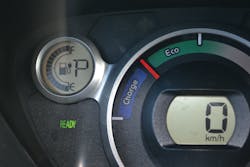University of Extrication: Electric Plug-In Vehicles – Part 2
SUBJECT: Electric Plug-In Vehicles
TOPIC: Electric Plug-In Vehicle Shut-down Techniques
OBJECTIVE: Understand the recommended procedure for powering down electric plug-in vehicles and why the sequence is important
TASK: Given an electric plug-in vehicle to review and inspect, the rescue team shall practice vehicle and electrical system shut-down procedures following the recommended sequence provided
Part 1 of this series familiarized responders with the Mitsubishi i-MiEV vehicle – a plug-in electric vehicle equipped with a high-voltage lithium-ion battery. In this University of Extrication article, we will describe a recommended shut-down process specifically when working on an electric plug-in vehicle. The seven steps of the Electric Vehicle Lock Out/Tag Out procedures are listed below;
- Identification of vehicle as EV
- Stabilize: chock/block
- Access interior
- Place vehicle in “Park”/set parking brake
- Turn ignition OFF
- Check instrument panel lights/indicators
- Shut down 12-volt electrical system
In the scenario we will use for this article, responders find a crash-damaged electric vehicle that needs to be powered down. Following our seven-step recommended Electric Vehicle Lock Out/Tag Out procedures, once the vehicle was identified as an electric vehicle(Step 1), responders quickly chock or block the wheels (Step 2). With wheels chocked, one responder will then access the interior of the vehicle; either through an already open door or a window (Step 3).
Once inside, the vehicle transmission is placed in the “Park” position and the emergency brake is set if these actions are possible (Step 4). Now, with these steps accomplished, the ignition is turned OFF (Step 5). The Mitsubuishi i-MiEV being used for our research is equipped with a typical ignition key. Once turned off, the recommendation is to place the ignition key on the dash to signify that the ignition has been turned off. Instead of an actual key, the inside rescuer might encounter a keyless ignition system. With these systems, turning the ignition off is accomplished by pressing the Power or Start/Stop button located on the instrument panel to the right side of the steering column.
Once the ignition is being turned off, the inside rescuer should immediately see something change on the instrument panel (Step 6). A light will go out, a needle on a gauge will drop, an indicator dims, etc. At this point, most of the shut-down procedure has been accomplished but we are not finished yet. We still have the vehicle’s 12-volt electrical system to deal with.
In our final step, we must locate and then access the 12-volt battery. Once the battery is located, responders have two choices. We can disconnect the ground and positive cables from the battery or we can cut the cables (Step 7). If the decision is made to cut the battery cables, then we should “double cut” the cables. Taking a “chunk” out of each cable assures that the fresh-cut ends will not touch each other and re-establish electrical continuity. Cutting cables should be done if disconnecting the cables is not a viable option. Disconnecting is the recommended action.
The issue responders face with an electric vehicle (EV) is that EVs, as well as hybrids, can continue to function with its 12-volt battery completely disconnected. This is due to the fact that a second source of 12-volt power comes from the high voltage battery through a DC to DC converter. This power keeps the electric vehicle completely functional even though the 12-volt battery has been completely taken out of the system.
During the research project with Mitsubuishi i-MiEV vehicle, testing was conducted to demonstrate the importance of following these steps in this specific order. The i-MiEV electric vehicle was placed in “Park” with the vehicle’s ignition in the ON position. In other words, although sitting still and in “Park,” the vehicle was fully functional at this time. The electric vehicle’s green READY light was clearly visible within the instrument cluster.
To show that all electric functions were operational, the headlights were turned on and the four-way hazard flashers were activated. Instead of following the recommended Lock Out/Tag Out sequence, researchers left the ignition switch in the ON position and all electrical accessories operating. The 12-volt battery was then worked with; disconnecting the ground and positive cables from the battery itself.
The demonstration showed that there was no change in the operational status of the i-MiEV when Lock Out/Tag Out is done in the wrong order. The vehicle remained fully operational even with the 12-volt battery completely disconnected. The vehicle’s interior READY light remained on, the hazard flashers continued to flash and the headlights burned bright. When placed in gear, the vehicle was able to be driven.
In this case, a second source of 12-volt electricity, routed from the high-voltage battery through the DC to DC converter, continued to provide enough 12-volt power to operate the vehicle.
The lesson learned with this research was that the seven-step sequence for powering down an EV is very important. In situations where a rescuer gains access to the 12-volt battery before the ignition is turned off, they should wait until the inside rescuer turns the ignition off. If the ignition is turned off first followed by taking away the 12-volt power, everything will power down as expected. If the ignition is still in the ON position when the battery is worked with, nothing will happen.
This information also justifies why responders should become familiar with the two alternative methods of powering down an EV when the ignition cannot be accessed due to crash damage or vehicle location/position. Many manufacturers recommend working with their vehicle’s manual disconnect device or will even state that responders could pull electrical fuses in a certain circuit panel box on the vehicle. These options are available within the specific manufacturer’s emergency response guide for their EV. All available guides for all existing hybrids as well as electric vehicles are available free of charge. The National Fire Protection Association has conveniently assembled all these guides on their electric vehicle training website. Visit www.evsafetytraining.org to review and download any documents that are of interest at no charge. They are great for training purposes and will stimulate discussion among your rescue personnel as you discuss EV emergency procedures.
TASK: Given an electric plug-in vehicle to review and inspect, the rescue team shall practice vehicle and electrical system shut-down procedures following the recommended sequence provided.
Read the rest of the series here:
Electric Vehicle Lock Out/Tag Out Procedures
- Identification of vehicle as EV
- Stabilize: chock/block
- Access interior
- Place vehicle in “Park”/set parking brake
- Turn ignition OFF
- Check instrument panel lights/indicators
- Shut down 12-volt electrical system

Ron Moore
RON MOORE, who is a Firehouse contributing editor, recently retired as a division chief with the McKinney, TX, Fire Department and now serves with Prosper, TX, Fire Rescue. He self-published the Vehicle Rescue 1-2-3 training manual and serves as the forum moderator for the extrication section of Firehouse.com . Moore can be contacted directly at [email protected].






